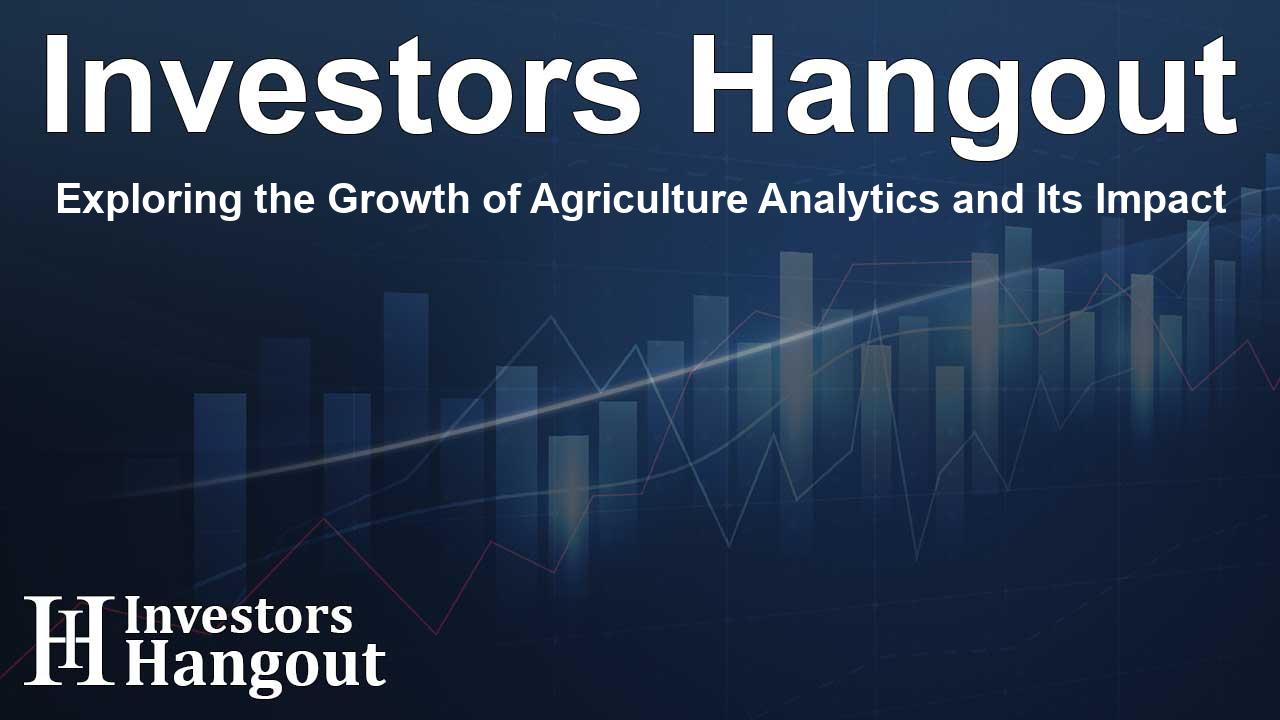Exploring the Growth of Agriculture Analytics and Its Impact

Transforming Agriculture Through Advanced Analytics
The Agriculture Analytics Market is on an impressive upward trajectory, forecasted to grow significantly in the coming years. This expansion is largely propelled by technological innovations and the increasing demand for sustainable farming practices. The overall market was valued at approximately USD 2.36 Billion in recent assessments and is projected to reach around USD 4.92 Billion in the near future, with an anticipated compound annual growth rate (CAGR) of 8.55%.
Technological Innovations in Agriculture
As the agricultural sector embraces modern technology, emerging tools like the Internet of Things (IoT), artificial intelligence (AI), and big data analytics play crucial roles. These advancements allow for real-time monitoring and analysis of vital agricultural data, offering insights related to soil health, weather patterns, and crop conditions. This information is invaluable for farmers who aim to enhance their resource management strategies, improve yields, and ultimately foster more sustainable agricultural practices.
Precision Agriculture: A Game Changer
Precision agriculture has become a focal point within the agriculture analytics market. By employing tailored solutions, the industry facilitates farmers in making informed decisions, minimizing waste and environmental impacts. Recent innovations in AI-driven analytics systems exemplify how technology can streamline processes and simplify decision-making for farmers. For example, companies are now focusing on predictive analytics to help anticipate agricultural challenges even before they arise, thereby safeguarding crops and ensuring optimal productivity.
Market Dynamics and Key Drivers
Several factors contribute to the robust growth of the agriculture analytics market. Among them, the rising global population combined with an escalated demand for food places immense pressure on agricultural systems. Farmers are increasingly leveraging analytics to optimize their production processes and ensure that food supply can meet this growing demand sustainably.
Service Sector Growth in Agriculture Analytics
While the solution segment leads the market, the service sector is also gaining momentum, with a projected CAGR of 9.60%. This growth is driven by a surge in demand for expert consultation, data management, and cloud-based solutions. As farmers begin to maximize the integration of technology into their practices, the request for tailored services and continuous support will noticeably rise.
Regional Insights: North America and Beyond
Currently, North America dominates the agriculture analytics market, holding a substantial portion of the market share. The early adoption of innovative technologies and a strong agricultural framework in the region have played key roles in this dominance. On the other hand, the Asia-Pacific region is anticipated to experience the fastest growth, motivated by the urgent need for efficient food production and the adoption of modern farming techniques.
Future of Livestock Analytics
In recent studies, the livestock farming segment within agriculture analytics has exhibited a notable growth rate, driven by the growing necessity for real-time health monitoring and efficient resource management. This evolving area offers exciting opportunities for increasing productivity and enhancing animal welfare through advanced tracking and analytics solutions.
Conclusion
As agriculture continues to evolve through technological advancements, analytics will serve as the backbone of sustainable farming movements. The market is poised for substantial growth, driven by innovations that assist farmers in optimizing their operations. With ongoing investments and an increasing focus on sustainability, agriculture analytics will undoubtedly play a pivotal role in shaping the future of the farming industry.
Frequently Asked Questions
What is the projected growth of the Agriculture Analytics Market?
The Agriculture Analytics Market is projected to grow from USD 2.36 Billion in 2023 to USD 4.92 Billion by 2032, reflecting a CAGR of 8.55%.
What technologies are influencing agriculture analytics?
Technologies such as IoT, AI, and big data are significantly influencing the agriculture analytics market, allowing for real-time data analysis and better decision-making.
Which segment is growing the fastest in agriculture analytics?
The service segment of agriculture analytics is expected to grow at a CAGR of approximately 9.60%, driven by increased demand for consultation and cloud-based services.
How important is precision agriculture?
Precision agriculture is vital as it helps farmers optimize resource use and improve crop yields while minimizing environmental impacts.
Where is the agriculture analytics market growing the fastest?
The Asia-Pacific region is projected to experience the fastest growth in agriculture analytics, fueled by the demand for efficient food production and modern farming techniques.
About The Author
Contact Thomas Cooper privately here. Or send an email with ATTN: Thomas Cooper as the subject to contact@investorshangout.com.
About Investors Hangout
Investors Hangout is a leading online stock forum for financial discussion and learning, offering a wide range of free tools and resources. It draws in traders of all levels, who exchange market knowledge, investigate trading tactics, and keep an eye on industry developments in real time. Featuring financial articles, stock message boards, quotes, charts, company profiles, and live news updates. Through cooperative learning and a wealth of informational resources, it helps users from novices creating their first portfolios to experts honing their techniques. Join Investors Hangout today: https://investorshangout.com/
The content of this article is based on factual, publicly available information and does not represent legal, financial, or investment advice. Investors Hangout does not offer financial advice, and the author is not a licensed financial advisor. Consult a qualified advisor before making any financial or investment decisions based on this article. This article should not be considered advice to purchase, sell, or hold any securities or other investments. If any of the material provided here is inaccurate, please contact us for corrections.
